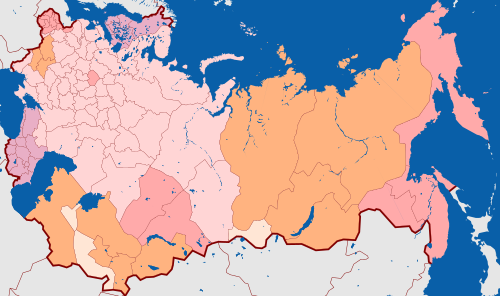

This article has multiple issues. Please help improve it or discuss these issues on the talk page. (Learn how and when to remove these template messages)
|
| Governorates of the Russian Empire | |
|---|---|
| Category | Subdivision of a unitary state |
| Location | Russian Empire |
| Created by | "On the establishment of the gubernias and cities assigned to them" |
| Created |
|
| Abolished |
|
| Number | 117 (8 initially) (as of 1914) |
| Subdivisions | |
Agovernorate (Russian: губе́рния, romanized: guberniya, pre-1918 spelling: губе́рнія, IPA: [ɡʊˈbʲɛrnʲɪjə]) was a major and principal administrative subdivision of the Russian Empire. After the Bolshevik Revolution in 1917, governorates remained as subdivisions in the Byelorussian, Russian and Ukrainian Soviet republics, and in the Soviet Union from its formation in 1922 until 1929. The term is also translated as governmentorprovince. A governorate was headed by a governor (губернатор, gubernator), a word borrowed from Latin gubernator, in turn from Greek kyvernítis (Greek: κυβερνήτης).
Selected governorates were united under an assigned governor-general such as the Grand Duchy of Finland, Congress Poland, Russian Turkestan and others. There were also military governors such as Kronstadt, Vladivostok and others. Aside from governorates, other types of divisions were oblasts (region) and okrugs (district).

This subdivision type was created by the edict (ukase) of Peter the Great on December 18, 1708 "On the establishment of the gubernias and cities assigned to them", which divided Russia into eight governorates.
In 1719, governorates were further subdivided into provinces (Russian: провинции, romanized: provintsii). Later the number of governorates was increased to 23.
| Governorates of the Russian Empire (1708-1726) | ||||||||||||||||||
| 1708-1710 | Kazan | Ingermanland | Azov | Smolensk | ||||||||||||||
| 1710-1713 | Saint Petersburg | |||||||||||||||||
| 1713-1714 | Moscow | Riga | ||||||||||||||||
| 1714-1717 | Nizhny Novgorod | |||||||||||||||||
| 1717-1719 | Astrakhan | |||||||||||||||||
| 1719-1725 | Nizhny Novgorod | Reval | ||||||||||||||||
| 1725-1726 | Voronezh | |||||||||||||||||
| 1726 | Smolensk | |||||||||||||||||
| The Governorates of Archangelgorod, Kiev and Siberia remained constant between 1708 and 1726. | ||||||||||||||||||

By the reform of 1775, subdivision into governorates and further into uezds (Russian: уезды), was based on population size, and the term guberniya was replaced by the synonym of Russian origin: namestnichestvo (наместничество), sometimes translated as "viceroyalty". The term guberniya, however, still remained in use. These viceroyalties were governed by namestniki (наместник) (literal translation: "deputy") or "governors general" (генерал-губернатор, general-gubernator). Correspondingly, the term "governorate general" (генерал-губернаторство, general-gubernatorstvo) was in use to refer to the actual territory being governed. The office of governor general had more administrative power and was in a higher position than the previous office of governor. Sometimes a governor general ruled several governorates.
By the ukase of the Russian Senate of December 31, 1796, the office of governorate general was demoted to the previous level of governorate, and Russia was again divided into governorates, which were subdivided into uezds, further subdivided into volosts (волость); nevertheless several governorates general made from several governorates existed until the Russian Revolution of 1917.
The governorate (Russian: губе́рния, Polish: gubernia, Swedish: län, Finnish: lääni) system was also applied to subdivisions of the Kingdom of Poland ("Russian Poland") and the Grand Duchy of Finland.
After the February Revolution, the Russian Provisional Government renamed governors into governorate commissars. The October Revolution left the subdivision in place, but the governing apparatus was replaced by governorate soviets (губернский совет).
Actual subdivisions of the Soviet Union into particular territorial units was subject to numerous changes, especially during the 1918–1929 period. Because of the Soviet Union's electrification program under the GOELRO plan, Ivan Alexandrov directed the Regionalisation Commission of Gosplan to divide the Soviet union into thirteen European and eight Asiatic oblasts, using rational economic planning rather than "the vestiges of lost sovereign rights".[1] Eventually, in 1929, the subdivision was replaced by the notions of oblast, okrug, and raion. Oblast as a unit was used even before the revolution, although unlike governorates it designated remote areas that usually incorporated huge swaths of land.
In post-Soviet states such as Russia and Ukraine, the term Guberniya is considered obsolete, yet the word gubernator was reinstated and is used when referring to a governor of an oblast or a krai.
The Russian Empire had nine governorates in modern-day Ukrainian territories: Chernigov, Kharkov, Kherson, Kiev, Podolia, Poltava, Volhynia, Yekaterinoslav, and Taurida. Additional lands annexed from Poland in 1815 were organized into the Kholm governorate in 1912.[2]
After the events of 1917, which led to the declaration of independence of the Ukrainian People's Republic, these governorates became subdivisions, which also annexed Ukrainian-inhabited parts of Mogilev, Kursk, Voronezh and Minsk governorates in 1918.[2][3] By the end of the Soviet–Ukrainian War in 1920, the Bolsheviks had made them[clarification needed] part of the Ukrainian SSR.[3] Soviet Ukraine was reorganized into 12 governorates, which were reduced to nine in 1922 upon the Soviet Union's founding, and then replaced with okruhas in 1925.[2]
The West Ukrainian People's Republic in former Austro-Hungarian Empire territory was not subdivided into governorates, and would be annexed by the Second Polish Republic from 1920 until the Soviet invasion of 1939.
There is another meaning of the word as it denoted a type of estate in Lithuania of the until 1917.
|
Slavic-language terms for administrative divisions
| |
|---|---|
| Current |
|
| Historical |
|